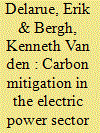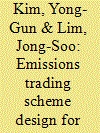|
|
|
Sort Order |
|
|
|
Items / Page
|
|
|
|
|
|
|
| Srl | Item |
| 1 |
ID:
150458


|
|
|
|
|
| Summary/Abstract |
In Europe, CO2 emissions from the electric power sector and energy intensive industries are capped under a cap-and-trade system (i.e., the EU ETS). When other indirect measures are taken to impact emissions in a specific sector under the cap (such as a push for renewables in the electric power sector), this has implications on the overall allowance price, and on CO2 emissions both from this specific sector and the other sectors under the cap. The central contribution of this paper is the derivation of impact curves, which describe these interactions, i.e., the impact on allowance price and the shift of emissions across sectors. From a set of detailed simulations of the electric power system operation, a so-called “emission plane” is obtained, from which impact curves can be derived. Focus is on interactions between CO2 abatement through fuel switching and measures affecting the residual electricity demand (such as deployment of renewables) in the electric power sector, as well as on interactions with other sectors, both in a short-term framework. A case study for Central-Western Europe is presented. The analysis reveals a substantial impact of renewables on CO2 emissions, and hence on emissions shifts across sectors and/or on the CO2 price.
|
|
|
|
|
|
|
|
|
|
|
|
|
|
|
|
| 2 |
ID:
186443


|
|
|
|
|
| Summary/Abstract |
Carbon prices and carbon caps need to be set at levels that will deliver the reduction targets necessary to keep global warming under 2 °C, aspiring to 1.5 °C above pre-industrial levels, in line with the Paris Agreement. Given both the urgency of the situation and the heterogeneity across countries and sectors, switching caps and switching prices may be the answer.
|
|
|
|
|
|
|
|
|
|
|
|
|
|
|
|
| 3 |
ID:
103342


|
|
|
|
|
| Publication |
2011.
|
| Summary/Abstract |
Current policies in the road transport sector fail to deliver consistent and efficient incentives for greenhouse gas abatement (see companion article by Creutzig et al., in press). Market-based instruments such as cap-and-trade systems close this policy gap and complement traditional policies that are required where specific market failures arise. Even in presence of strong existing non-market policies, cap-and-trade delivers additional abatement and efficiency by incentivizing demand side abatement options. This paper analyzes generic design options and economic impacts of including the European road transport sector into the EU ETS. Suitable points of regulation are up- and midstream in the fuel chain to ensure effectiveness (cover all emissions and avoid double-counting), efficiency (incentivize all abatement options) and low transaction costs. Based on year 2020 marginal abatement cost curves from different models and current EU climate policy objectives we show that in contrast to conventional wisdom, road transport inclusion would not change the EU ETS allowance price. Hence, industrial carbon leakage induced by adding road transport to the EU ETS may be less important than previously estimated.
|
|
|
|
|
|
|
|
|
|
|
|
|
|
|
|
| 4 |
ID:
136195


|
|
|
|
|
| Summary/Abstract |
The electricity market, monopolistic in nature, with government price regulation, poses a serious challenge for policy makers with respect to the cost-effectiveness of emissions trading, particularly in Asian countries. This paper argues that a cap-and-trade regulatory system for indirect emissions combined with a rate-based allocation system for direct emissions can achieve market efficiency even in the presence of price and quantity controls in the electricity market. This particular policy mix could provide appropriate incentives for industries to reduce their electricity consumption while inducing power producers to reduce their direct carbon emissions cost-effectively in conditions where there is strict government control of electricity prices. Another advantage of the suggested policy mix is that it allows carbon leakage in cross-border power trades to be effectively eliminated.
|
|
|
|
|
|
|
|
|
|
|
|
|
|
|
|
| 5 |
ID:
105817


|
|
|
|
|
| Publication |
2011.
|
| Summary/Abstract |
Three types of policies that are prominent in the federal debate over addressing greenhouse gas emissions in the United States are a cap-and-trade program (CTP) on emissions, a renewable portfolio standard (RPS) for electricity production, and tax credits for renewable electricity producers. Each of these policies would have different consequences, and combinations of these policies could induce interactions yielding a whole that is not the sum of its parts. This paper utilizes the Haiku electricity market model to evaluate the economic and technology outcomes, climate benefits, and cost-effectiveness of three such policies and all possible combinations of the policies. A central finding is that the carbon dioxide (CO2) emissions reductions from CTP can be significantly greater than those from the other policies, even for similar levels of renewable electricity production, since of the three policies, CTP is the only one that distinguishes electricity generated by coal and natural gas. It follows that CTP is the most cost-effective among these approaches at reducing CO2 emissions. An alternative compliance payment mechanism in an RPS program could substantially affect renewables penetration, and the electricity price effects of the policies hinge partly on the regulatory structure of electricity markets, which varies across the country.
|
|
|
|
|
|
|
|
|
|
|
|
|
|
|
|
| 6 |
ID:
168312


|
|
|
|
|
| Summary/Abstract |
Carbon emission verification is one of the key factors required for proper implementation of a cap-and-trade (C&T) system. However, to obtain more revenue, emission generating companies (GCs) may collude with third-party verifiers (3 PVs) and conceal real carbon emission data. Based on actual practice of Shenzhen's C&T system, a three-player game model has been devised in this paper to analyze the behaviors among GCs, 3 PVs and government. Given the government's current piecewise linear re-verification policy, the optimal reported carbon intensity for GCs has been provided. Our research reveals that if the actual carbon intensity is larger than historical carbon intensity GCs may report less carbon intensity and conceal actual carbon emission. To deal with this issue, a new exponential re-verification policy is proposed. Based on authentic data from Shenzhen's C&T system, the experimental results show that the government should devote more attention to GCs with a decreasing industrial product output value-added (IVA) than to those with high carbon emissions when selecting GCs for re-verification. Our experiments also illustrate that the new policy outperforms the current one on both total concealed amount of carbon emission and total re-verification cost if the initial re-verification probability is set within a specific range.
|
|
|
|
|
|
|
|
|
|
|
|
|
|
|
|
| 7 |
ID:
149967


|
|
|
|
|
| Summary/Abstract |
We investigate the current use of public revenues which are generated through both carbon taxes and cap-and-trade systems. More than $28.3 billion in government “carbon revenues” are currently collected each year in 40 countries and another 16 states or provinces around the world. Of those revenues, 27% ($7.8 billion) are used to subsidize “green” spending in energy efficiency or renewable energy; 26% ($7.4 billion) go toward state general funds; and 36% ($10.1 billion) are returned to corporate or individual taxpayers through paired tax cuts or direct rebates. Cap-and-trade systems ($6.57 billion in total public revenue) earmark a larger share of revenues for “green” spending (70%), while carbon tax systems ($21.7 billion) more commonly refund revenues or otherwise direct them towards government general funds (72% of revenues). Drawing from an empirical dataset, we also identify various trends in systems’ use of “carbon revenues” in terms of the total revenues collected annually per capita in each jurisdiction and offer commensurate qualitative observations on carbon policy design choices.
|
|
|
|
|
|
|
|
|
|
|
|
|
|
|
|
| 8 |
ID:
150680


|
|
|
|
|
| Summary/Abstract |
The European Commission discusses the change of free allocation plans to guarantee a stable market equilibrium. Selling over-allocated contracts effectively depreciates prices and negates the effect intended by the regulator to establish a stable price mechanism for CO2 assets. Our paper investigates mispricing and allocation issues by quantitatively analyzing variance risk premia of CO2 markets over the course of changing regimes (Phase I-III) for three different assets (European Union Allowances, Certified Emissions Reductions and European Reduction Units). The research paper gives recommendations to regulatory bodies in order to most effectively cap the overall carbon dioxide emissions.
|
|
|
|
|
|
|
|
|
|
|
|
|
|
|
|
| 9 |
ID:
176708


|
|
|
|
|
| Summary/Abstract |
Why do some governments adopt policies to mitigate climate change while others do not? In this study, I illustrate the importance of industrial organization in shaping prospects for climate mitigation policy. Using a difference-in-differences analysis, I show that U.S. states which adopt electricity market liberalization laws are subsequently fifteen to forty-three percentage points more likely to adopt a renewable portfolio standard and fifteen to thirty percentage points more likely to adopt a cap-and-trade program. I argue that the forced reduction in market share of incumbent utilities associated with market liberalization laws undermined the political dominance of legacy producers and facilitated the growth of independent power producers (IPPs). Following liberalization, I show how these firms disproportionately benefited from the development of renewable energy, and how their growth in market share corresponded with a rise in political activity, thus offering a countervailing industrial interest-group influence to legacy producers. These findings demonstrate the importance of industrial organization in shaping long-run prospects for climate mitigation. More generally, this study sheds light on how government interventions can shape industrial interest-group dynamics.
|
|
|
|
|
|
|
|
|
|
|
|
|
|
|
|
|
|
|
|
|